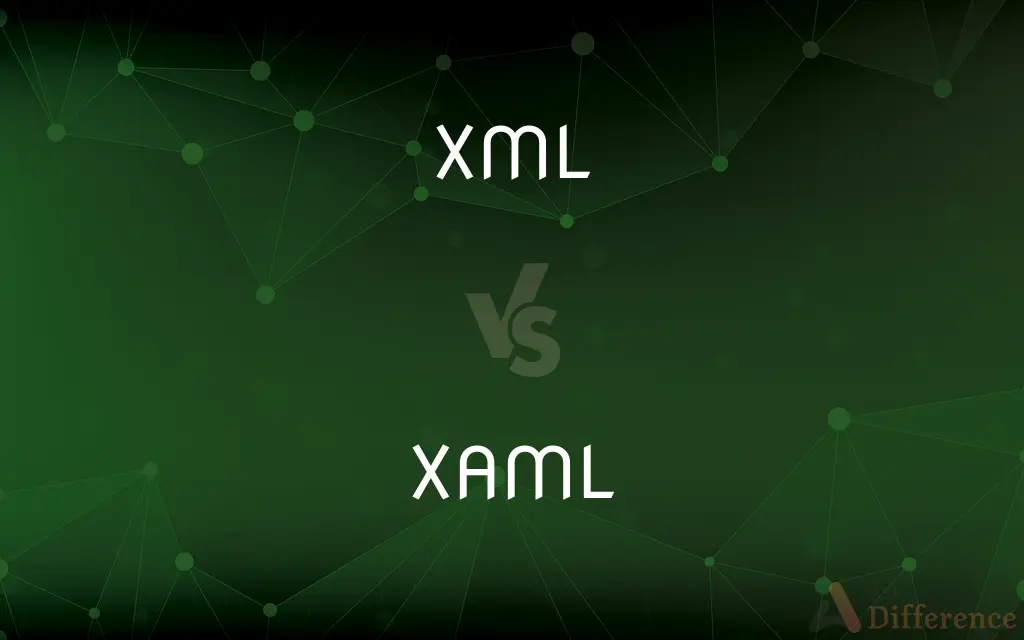XML vs. XAML — What's the Difference?
By Tayyaba Rehman — Published on December 20, 2023
XML is a markup language for structuring data, while XAML is a UI language for defining and linking interface elements in .NET applications.

Difference Between XML and XAML
Table of Contents
ADVERTISEMENT
Key Differences
XML and XAML are both markup languages, but they serve different purposes. XML is primarily used to structure data, allowing for data storage and transport, whereas XAML is used specifically for designing user interfaces in .NET applications.
XML is versatile and can be applied in various contexts, from web services to configuration files. XAML, on the other hand, is closely tied with the Windows Presentation Foundation (WPF), providing a declarative way to design user interfaces.
The structure of XML is quite general, allowing for the definition of custom tags to represent data entities. XAML is more specialized, containing built-in tags corresponding to various UI elements, like buttons and text boxes.
While XML focuses on data representation and has a broader scope in terms of application, XAML focuses on visual representation and user interaction. It's crucial to note that XAML often works in tandem with backend code, typically C# or VB.NET, to bring functionality to the UI components.
One key similarity between XML and XAML is their human-readable format, allowing developers to easily read and edit the content. However, the contexts in which they're applied set them apart: XML for general data representation and XAML for .NET application interfaces.
ADVERTISEMENT
Comparison Chart
Primary Purpose
Data structuring
UI design for .NET applications
Application Scope
Broad (web services, config files, etc.)
Specific (primarily Windows Presentation Foundation)
Built-in Tags
No, custom tags are defined
Yes, corresponds to UI elements
Interaction with Languages
Can be paired with many languages
Typically paired with C# or VB.NET
Human-Readable Format
Yes, easily editable
Yes, easily editable
Compare with Definitions
XML
A language that can represent structured data with custom tags.
The employee data was organized in an XML document with custom tags.
XAML
A declarative UI language used in .NET applications.
The user interface of the software was designed using XAML.
XML
A markup language for encoding documents in a format both human-readable and machine-readable.
The configuration settings were stored in an XML file.
XAML
A tool for separating presentation (UI) from logic in applications.
With XAML handling the interface, the C# code focused solely on functionality.
XML
A standard for designing text formats for data interchange.
The web service returned data in an XML format.
XAML
A language that pairs with C# or VB.NET for interactive application development.
The XAML defined the buttons, while the C# code determined their actions.
XML
A language that doesn't do anything on its own but is used as a base for creating other languages.
SVG, used for vector graphics, is based on XML.
XAML
A language associated with the Windows Presentation Foundation (WPF).
He specialized in creating WPF applications and frequently wrote XAML code.
XML
A tool for creating information formats and sharing both the format and data.
The database export was saved as an XML to be used in another application.
XAML
An XML-based language for creating and initializing .NET objects.
Using XAML made it easy to visualize the layout of the application.
XML
An international standard metalanguage for creating markup languages that structure digital information in a way that allows for the exchange, display, and storage of data independent of proprietary operating systems and hardware devices.
Common Curiosities
What does XML stand for?
XML stands for Extensible Markup Language.
What is the main use of XAML?
XAML is primarily used for designing user interfaces in .NET applications.
Are XML files executable?
No, XML files are not executable but are used to structure and transport data.
Is XML case-sensitive?
Yes, XML is case-sensitive, meaning tag names' capitalization matters.
Is XAML specific to Microsoft technologies?
Yes, XAML is primarily associated with Microsoft's Windows Presentation Foundation (WPF).
How does XML differ from HTML?
While both are markup languages, XML focuses on data structuring, while HTML focuses on data presentation.
Are there tools to visually design XAML interfaces?
Yes, tools like Microsoft Blend allow for visual XAML design.
Can XML be used for web development?
Yes, XML can be used in web development, especially in data interchange and web services.
Is XAML used outside of UI design?
While primarily for UI, XAML can represent .NET objects in general.
How do XML parsers work?
XML parsers read and interpret XML content, checking correctness and transforming data as needed.
Can XAML interfaces be used on non-Windows platforms?
While primarily for Windows, tools like Xamarin allow XAML interfaces on other platforms.
Is there a specific programming logic in XAML?
XAML defines the UI layout, while logic is typically handled by languages like C# or VB.NET.
Can I use XAML with languages other than C# or VB.NET?
Typically, XAML pairs with C# or VB.NET, but other integrations are technically possible.
Why is XML widely used in web services?
XML offers a standardized, human-readable format for data interchange, making it ideal for web services.
Can XML be used for configuration files?
Yes, XML is commonly used for configuration files due to its structured format.
Share Your Discovery

Previous Comparison
Pumps vs. Stilettos
Next Comparison
Pellet vs. GranuleAuthor Spotlight
Written by
Tayyaba RehmanTayyaba Rehman is a distinguished writer, currently serving as a primary contributor to askdifference.com. As a researcher in semantics and etymology, Tayyaba's passion for the complexity of languages and their distinctions has found a perfect home on the platform. Tayyaba delves into the intricacies of language, distinguishing between commonly confused words and phrases, thereby providing clarity for readers worldwide.












































